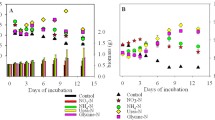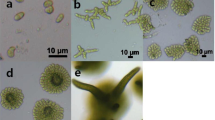Abstract
Freshwater inputs from rivers alter salinity of estuaries, and are also important conduits for the delivery of nutrients such as nitrogen and phosphorus. We studied the impact of freshwater inputs on primary producers in the lower Housatonic River estuary in Long Island Sound, U.S.A. We conducted a laboratory experiment with Ulva intestinalis (syn. Enteromorpha intestinalis) (Linnaeus), a common green macroalgae that can have a high biomass in eutrophic systems. U. intestinalis was collected from three sites around the estuary that varied in salinity and nutrient concentration. Algae from three sites were grown in four treatments containing different proportions of Housatonic River water to mimic the gradient in riverine influence in the estuary. As the percentage of Housatonic River water increased, nitrogen and phosphorus concentration increased and salinity decreased. Growth of U. intestinalis collected from lower salinity sites was higher in treatments containing Housatonic River water than in those containing only Long Island Sound water. Conversely, U. intestinalis collected from Long Island Sound grew best in the treatment with no river water. Previous studies showed that U. intestinalis growth is stimulated by high nutrient concentration and depressed by low salinity; however, the reduction in growth at low salinity may be mitigated by increased nutrients. Our results support these studies and suggest that for populations of U. intestinalis that have experienced reduced salinity in their environment, the negative impacts of reduced salinity may be outweighed by the positive impacts of the high nutrient concentration in Housatonic River water.
Similar content being viewed by others
References
N. G. Barr T. A. V. Rees (2003) ArticleTitleNitrogen status and metabolism in the green seaweed Enteromorpha intestinalis: an examination of three natural populations Marine Ecology Progress Series 249 133–144
K. H. Dunton B. Hardegree T. E. Whitledge (2001) ArticleTitleResponse of estuarine marsh vegetation to interannual variations in precipitation Estuaries 24 851–861
P. Fong J. B. Zedler R. M. Donohoe (1993) ArticleTitleNitrogen vs. phosphorus limitation of algal biomass in shallow coastal lagoons Limnology and Oceanography 38 906–923
P. Fong R. M. Donohoe J. B. Zedler (1994) ArticleTitleNutrient concentration in tissue of the macroalgae Enteromorpha as a function of nutrient history: an experimental evaluation using field microcosms Marine Ecology Progress Series 106 273–281
P. Fong K. E. Boyer J. S. Desmond J. B. Zedler (1996) ArticleTitleSalinity stress, nitrogen competition, and facilitation: what controls seasonal succession of two opportunistic green macroalgae? Journal of Experimental and Marine Biology and Ecology 206 203–221 Occurrence Handle1:CAS:528:DyaK28Xns1equ7c%3D
P. Fong K. E. Boyer J. B. Zedler (1998) ArticleTitleDeveloping an indicator of nutrient enrichment in coastal estuaries and lagoons using tissue nitrogen content of the opportunistic alga, Enteromorpha intestinalis (L. Link) Journal of Experimental and Marine Biology and Ecology 231 63–79
R. M. Fujita (1985) ArticleTitleThe role of nitrogen status in regulating transient ammonium uptake and nitrogen storage by macroalgae Journal of Experimental and Marine Biology and Ecology 92 283–301 Occurrence Handle1:CAS:528:DyaL28XhslOhsg%3D%3D
H. S. Hayden J. Blomster C. A. Maggs P. C. Silva M. J. Stanhope J. R. Waaland (2003) ArticleTitleLinneaus was right all along: Ulva and Enteromorpha are not distinct genera European Journal of Phycology 38 277–294
C. R. Hopkinson SuffixJr. J. J. Vallino (1995) ArticleTitleThe relationships among man’s activities in watersheds and estuaries: a model of runoff effects on patterns of estuarine community metabolism Estuaries 18 598–621 Occurrence Handle1:CAS:528:DyaK28XitVOktQ%3D%3D
D. J. Innes (1987) ArticleTitleGenetic structure of asexually reproducing Enteromorpha linza (Ulvales: Chlorophyta) in Long Island Sound Marine Biology 94 459–467
K. Kamer P. Fong (2001) ArticleTitleNitrogen enrichment ameliorates the negative effects of reduced salinity on the green macroalga Enteromorpha intestinalis Marine Ecology Progress Series 218 87–93 Occurrence Handle1:CAS:528:DC%2BD3MXptVOltbk%3D
K. Y. Kim I. K. Lee (1996) ArticleTitleThe germling growth of Enteromorpha intestinalis (Chlorophyta) in laboratory culture under different combinations of irradiance and salinity and temperature and salinity Phycologia 35 327–331
I. Martins J. M. Oliveira M. R. Flindt J. C. Marques (1999) ArticleTitleThe effect of salinity on the growth rate of the macroalgae Enteromorpha intestinalis (Chlorophyta) in the Mondego estuary (west Portugal) Acta Oecologica 20 259–265
I. Martins M. A. Pardal A. I. Lillebo M. R. Flindt J. C. Marques (2001) ArticleTitleHydrodynamics as a major factor controlling the occurrence of green macroalgal blooms in a eutrophic estuary: a case study on the influence of precipitation and river management Estuarine, Coastal, and Shelf Science 52 165–177
NYSDEC & CTDEP, 2000. A total maximum daily load analysis to achieve water quality standards for dissolved oxygen in Long Island Sound. Prepared in conformance with Section 303(d) of the Clean Water Act and the Long Island Sound Study
L. J. Poole J. A. Raven (1997) The biology of Enteromorpha F. E. Round D. J. Chapman (Eds) Progress in Phycological Research Biopress Ltd. Bristol 1–148
R. A. Reed G. Russell (1979) ArticleTitleAdaptation to salinity stress in populations of Enteromorpha intestinalis (L) Link Estuarine and Coastal Marine Science 8 251–258
R. Taylor R. L. Fletcher J. A. Raven (2001) ArticleTitlePreliminary studies on the growth of selected ‘green tide’ algae in laboratory culture: effects of irradiance, temperature, salinity, and nutrients on growth rate Botanica Marina 44 327–336
Author information
Authors and Affiliations
Corresponding author
Additional information
This paper has not been submitted elsewhere in identical or similar form, nor will it be during the first three months after its submission to Hydrobiologia.
Rights and permissions
About this article
Cite this article
McAvoy, K., Klug, J. Positive and negative effects of riverine input on the estuarine green alga Ulva intestinalis (syn. Enteromorpha intestinalis) (Linneaus). Hydrobiologia 545, 1–9 (2005). https://doi.org/10.1007/s10750-005-1923-5
Received:
Revised:
Accepted:
Issue Date:
DOI: https://doi.org/10.1007/s10750-005-1923-5




